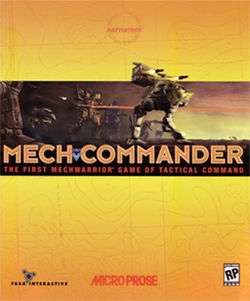MechCommander
| MechCommander | |
|---|---|
 | |
| Developer(s) | FASA Interactive |
| Publisher(s) | MicroProse |
| Designer(s) |
Ross Babcock Tom Dowd Mitch Gitelman Tim Ryan Steve Scott Denny Thorley Jordan Weisman |
| Programmer(s) | Glenn Doren |
| Writer(s) |
Tom Dowd Joel Machak Jordan Weisman |
| Composer(s) | Duane Decker |
| Platform(s) | Windows |
| Release date(s) | 1998 |
| Genre(s) | Real-time tactics, Mecha |
| Mode(s) | Single player, Multiplayer over Modem, Serial, Network or Internet |
MechCommander is the second real-time tactics (RTT) video game based on FASA's BattleTech/MechWarrior franchise (though often being called a real-time strategy game), developed by FASA Interactive and distributed by MicroProse. MechCommander was released in 1998. It had an expansion which was later combined with the original title and released as MechCommander Gold. A sequel also exists (distributed by Microsoft)—MechCommander 2. MicroProse also used many of the ideas in their 2000 Starship Troopers game.
Overview
MechCommander, in being a squad-based RTT, is more in the lines of X-COM: Apocalypse than RTS games like Age of Empires or StarCraft.
Gameplay
The player assumes the role of the commander of Zulu company from the Federated Commonwealth's First Davion Guards, a member of the Inner Sphere (IS). The planet Port Arthur must be taken back from the Clan Smoke Jaguar. The game's campaign progresses through 30 different missions broken into 5 operations with 6 missions apiece. Each mission consists of a number of objectives which may include destroying enemy units, capturing or defending enemy units, protecting friendly units, and capturing and defending bases. Some missions must be completed within a certain time limit.
In each mission, the player controls a limited number of units which are either mechs or support vehicles. Each mission restricts both the combined tonnage and the number of units allowed. Briefings are supplied prior to the start of the mission which lists the objectives and other relevant information. A wide range of strategies and tactics may be used on any given mission, and the player can customize his or her forces for each one.
In between missions the player can repair and refit mechs, assign mechwarriors to each mech and purchase mechs, vehicles, mechwarriors, and components. These items are purchased with Resource Points which are awarded for completing previous mission objectives. Few mechs, vehicles, mech pilots, and components can be purchased at the beginning of the campaign, but more become available as the game progresses. However, only IS technology can be purchased. Clan technology such as weaponry and new mechs must be salvaged from the battlefield. Salvaging equipment is an important feature of the game.
Each mech is piloted by a mechwarrior. Pilots increase in skill as they use them during missions. The more missions and kills a particular pilot has, the more experienced and valuable he or she becomes. If a pilot gains enough experience, he or she will increase in rank. The four ranks from least to greatest are "green," "regular," "veteran," and "elite." Rank determines how effective a pilot is in a certain class of mechs (light, medium, heavy, or assault).
MechCommander: Desperate Measures
MechCommander: Desperate Measures is an expansion pack that was released in 1999. Set immediately after the liberation of Port Arthur, the player once again assumes command of Zulu company in a campaign to liberate the desolate planet Cermak in the Periphery, taken by a renegade Smoke Jaguar, Star Colonel Marcus Kotare (a character that was featured briefly in MechWarrior 2: Mercenaries), for an unknown reason that is revealed later in game. Once again, the player starts with inferior Inner Sphere mechs (pilots and mechs from original campaign cannot be exported into expansion), though both mechs and pilots are better than in the start of the original campaign. The expansion features a total of three campaigns. Aside from the missions, the expansion also includes a new soundtrack, new landscapes along with redesigned and new buildings, new weapons, three new mechs for each side—Stiletto, Bushwacker, and Mauler for IS and Shadow Cat, Nova Cat and Turkina for the Clan, and new vehicles including Alacorn, Pilum and Regulator tanks, as well as ammo trucks that also doubled as mobile bombs and Centipede scout vehicles. Desperate Measures also acted as testbed for the concept of custom NPC mechs that had their own names (like Kotare's Turkina), weapon configurations and overall superiority to the standard modifications. This idea was carried on to, and greatly improved in, MechCommander 2.
References
External links
| ||||||||||||||||||||||||||